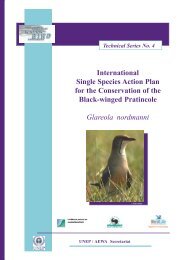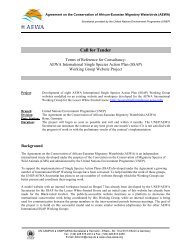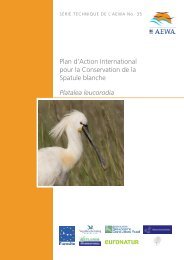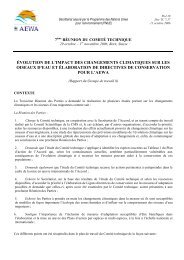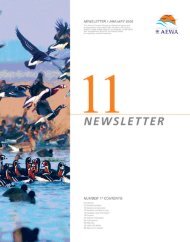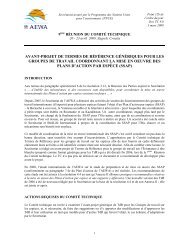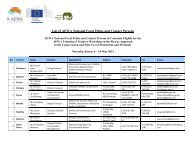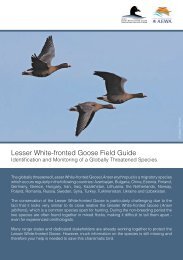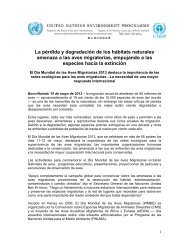International Single Species Action Plan for the ... - AEWA
International Single Species Action Plan for the ... - AEWA
International Single Species Action Plan for the ... - AEWA
You also want an ePaper? Increase the reach of your titles
YUMPU automatically turns print PDFs into web optimized ePapers that Google loves.
<strong>AEWA</strong> Technical Series No. 36<br />
2. Available Key Knowledge<br />
Annex 2 contains a table showing <strong>the</strong> latest quantitative and qualitative data (and<br />
corresponding sources) available <strong>for</strong> each of <strong>the</strong> ‘Principal Range States’ (see section 1.4 <strong>for</strong><br />
definition) as well as a country-by-country text summarizing <strong>the</strong> current state of knowledge in<br />
both ‘Principal Range States’ and ‘O<strong>the</strong>r EU/<strong>AEWA</strong> countries’. The Annex reflects <strong>the</strong> rapid<br />
(and ongoing) increase in <strong>the</strong> quantity and quality of ‘Key Knowledge’ about <strong>the</strong> species<br />
during <strong>the</strong> last ten years as a direct result of concerted field research and, especially, satellite<br />
tracking programmes. The following is a brief summary <strong>for</strong> <strong>the</strong> Principal Range States only;<br />
additonal references/sources are cited in Annex 2.<br />
Azerbaijan<br />
Formerly wintered in large numbers on <strong>the</strong> shores of <strong>the</strong> Caspian Sea (c.25,000 as recently as<br />
<strong>the</strong> late 1970s/early 1980s), but major decline since, with 1,500 to 7,000 estimated in 1996.<br />
The species’ status over <strong>the</strong> next ten years was unclear, owing to a lack of systematic count<br />
data. However, it seemed likely that <strong>the</strong> country remained an important wintering site <strong>for</strong> <strong>the</strong><br />
Western main population, given that in March 2001 large staging flocks were found in <strong>the</strong><br />
Kyzyl Agach area (565 birds) and in <strong>the</strong> Ag-Gel Zapovednik (1,800 - 2,000 birds) (Heinicke<br />
& Ryslavy 2002). Such a conclusion has been rein<strong>for</strong>ced by new in<strong>for</strong>mation <strong>for</strong> <strong>the</strong> period<br />
2006 to 2008.<br />
A satellite-tagged bird staged in Azerbaijan <strong>for</strong> several days in November 2004 be<strong>for</strong>e<br />
wintering in Iraq, while a pair satellite-tagged in <strong>the</strong> Polar Ural region of Russia in August<br />
2006 reached Azerbaijan in late October (via <strong>the</strong> Yamal Peninsula and Ob Valley, Russia;<br />
Kostanay region of north-west Kazakhstan, delta of <strong>the</strong> Ural River on <strong>the</strong> nor<strong>the</strong>rn shore of<br />
<strong>the</strong> Caspian Sea). The male wintered in Azerbaijan, but <strong>the</strong> female’s transmitter ceased<br />
working in mid-December. In addition, two birds satellite-tagged on <strong>the</strong> Putorana Plateau<br />
(Russia), also in summer 2006, staged in <strong>the</strong> border area between Iran and Azerbaijan in<br />
November, be<strong>for</strong>e moving to Iraq (http://www.piskulka.net/Satellite%20tracking.htm).<br />
In January 2008 <strong>the</strong> most important goose wintering sites in <strong>the</strong> country, including those used<br />
by <strong>the</strong> satellite-tagged Lesser White-fronted Geese from <strong>the</strong> Polar Ural breeding grounds,<br />
were surveyed in <strong>the</strong> field. No Lesser White-fronted Geese were found at Hinar in <strong>the</strong> Mil<br />
Steppe, or at Lake Hadjinour in <strong>the</strong> foothills of <strong>the</strong> Greater Caucasus. At Kyzyl Agach Nature<br />
Reserve approximately 4,500 geese were counted, despite extremely harsh winter conditions.<br />
Lesser White-fronts accounted <strong>for</strong> 50% of all geese observed. The percentage of juveniles<br />
(14%) indicates that <strong>the</strong> breeding season had been average (T. Aarvak).<br />
Bulgaria (EU)<br />
Occurs regularly in small numbers at goose staging and wintering sites on <strong>the</strong> Black Sea<br />
coast, notably Lakes Shabla and Durankulak, where up to 100 birds have been estimated to<br />
occur in some years (Petkov, Oien, Aarvak, 1999). The species also occurs in <strong>the</strong> Danube<br />
floodplain, notably Lake Srebarna and <strong>the</strong>re are sporadic observations in o<strong>the</strong>r parts of <strong>the</strong><br />
country. The fact that <strong>the</strong> species is recorded during casual birdwatching at goose wintering<br />
sites suggests its regular presence and it is thought that up to 100-150 birds may stage and<br />
over-winter when large numbers of geese reach Bulgaria. It is thought that <strong>the</strong> Lesser Whitefronts<br />
wintering on <strong>the</strong> Black Sea coast, scattered among flocks of Greater White-fronted<br />
Geese, belong to <strong>the</strong> Western main population (S. Dereliev, N. Petkov, pers. comm.).<br />
In 1998 satellite tracking has shown that birds from <strong>the</strong> Fennoscandian population migrate<br />
across Bulgaria to reach <strong>the</strong>ir Greek/Turkish wintering grounds (N. Petkov, pers. comm.).<br />
Small numbers of Lessers have also been recorded among Greater White-fronted Geese in<br />
Pyasachnik Reservoir (an IBA) located in <strong>the</strong> Maritza floodplain (Evros in Greek). This site<br />
<strong>International</strong> <strong>Single</strong> <strong>Species</strong> <strong>Action</strong> <strong>Plan</strong> <strong>for</strong> <strong>the</strong> Conservation of <strong>the</strong> Lesser White-fronted Goose 21



